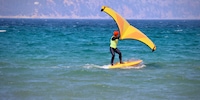
Background information
Siri’s outdoor lab: I learn to wing foil in a week – almost
by Siri Schubert

The Swiss brand Indiana got rolling with skateboards, is surfing the SUP wave of success and is taking off with foils. Managed from Oberrieden, the small company wants to play first fiddle in the concert of the big names.
First, the conductor serves Dar-Vida. "Do you want some?" asks Maurus Strobel, CEO of Indiana Paddle & Surf, and reaches for a dry snack himself. Lunch is cancelled today in the showroom in Oberrieden on the shores of Lake Zurich, where the boards rise to the ceiling like giant shark's teeth. There's a lot to do, a lot to talk about. Of the passion and epoxy resin that went into the boards. Of small details and big successes. An hour and a half of shop talk reveals a lot about why Indiana has successfully established itself in water sports. A good ten years ago, the skateboard brand took its first step "from the streets to the ocean", as Strobel puts it.
He now sits in the sun and looks out at boats bobbing on buoys. A few suitable metaphors could easily be fished out of the water, but Strobel brings the music into play. "We see ourselves a bit like a conductor with an orchestra," says the man, who also used to own a PR agency, with a sure instinct for punchy sentences. For him, it's all about the team and the well-rehearsed processes that are needed all over the world to produce high-quality work.
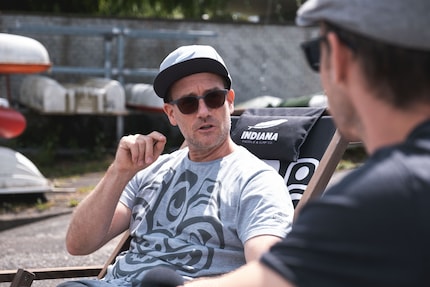
His relaxed look should not hide the fact that there is meticulous work behind it. Of course, the 45-year-old is wearing neither tails nor a bow tie, but sunglasses, a T-shirt and a company cap. The logo on it, half board, half feather, is intended to symbolise the easy life. "Many people only see the feather, not the board," says Strobel. Customers visualise the lightness they desire. For the makers, on the other hand, the board immediately catches the eye.
The logo is also a commitment: We do everything with boards.
In the past, the boards mainly rolled over the tarmac. Strobel was world champion in slalom skateboarding twice, in 2004 and 2005. As a team rider and colleague of Indiana founder Christof Peller, who designed the first skateboards in his laundry room in Herrliberg in 1989. They launched Indiana SUP together in 2010.
Peller has since returned to skateboards, while Strobel is responsible for water sports with Indiana Paddle & Surf under the umbrella of White Wave AG, which was founded in 2016. Sounds big. But the core team in the new office consists of one woman and four men. "It's still a small SME," says Strobel. "But I never thought it would grow to these dimensions." How did it come about?
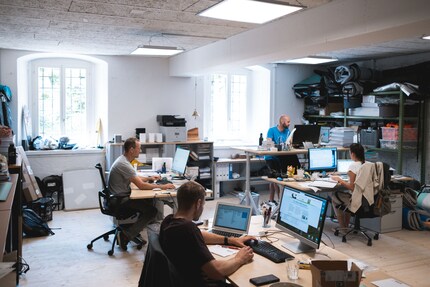
"We do everything with boards" - that's the shortest possible answer to the question about the formula for success. How we managed to do "everything with boards" successfully is a longer story. It begins on Lake Zurich, leads via Hawaii to China, takes place in Croatia, tells of a wave of success with a digital flaw, container ships, air freight and the Trans-Siberian Railway. It begins at the place of longing for all those who love boards and boards.
"My first time stand-up paddling was in Hawaii in 2008," says Strobel, who was actually drawn to the dream island of Maui for surfing and kitesurfing. "The waves weren't that high at the time, so I tried it out for a few days," he recalls. "The board was huge and difficult to turn. I was a bit scared in the waves, but it was fun." The experience was impressive, and on the journey home he had an obvious thought in his luggage: "If I like it, I'm sure others will like it too." Thought, done. Using their existing contacts, the skateboard experts launched the first SUP line in 2010. Two hardboards from the Indiana brand.
The first time I stood on my own board was a great feeling. It was still something special back then.
The early stand-up paddlers are exotic. They were eyed "like the saviour walking on water", says Strobel with a laugh. However, the Indiana Orchestra gradually learnt the ropes and was able to get over any hiccups during rehearsals: "In the beginning, we had to learn the hard way. We had production problems, we had quality problems, but always with very small quantities." Then the boom began. With the advent of inflatable SUPs, the masses became enthusiastic about the sport. The inflatable boards are the key to commercial success, which was not initially foreseeable for the makers: "We enjoyed it and wanted products that were fun for us."
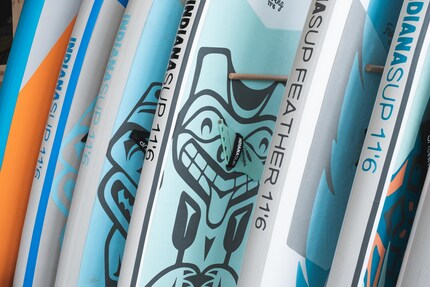
The board pioneers from Lake Zurich didn't think much of the inflatables at first, but that quickly changed. "They are easier to transport and store, are lighter and don't break if you drop one," says the CEO, listing the advantages. "Our beautiful epoxy boards then have a hole in them." So the search for suitable partners begins. In 2014, the Indiana crew found a factory that could produce to their quality standards. And business picks up. "That was the step from hobby to professional brand," recalls Strobel. "When the volumes increased, we had good producers. We had already made the mistakes."
Paying a lesson and doing your homework doesn't automatically make you successful. The market is too big, the offers too similar at first glance. It is almost impossible for newcomers to recognise the quality of the colourful boards. They see the price, and the price war is tough. So it's invaluable when an independent judgement turns out to be the best PR. In 2017 "Kassensturz" tested nine SUP models under 1000 francs and chose Indiana's Family Pack as the test winner.
"That was a milestone," says Strobel, laughing at the perceived reaction in the country: "A Swiss brand? Wow, that's cool! I have to buy it!" Around a hundred boards were gone after the first night. "An email went straight to China: produce as many as you can!" Three weeks later, the Family Pack was on sale, but supplies were quickly transported to Switzerland by container ship and air freight.
The reputation of the brand is growing.
The reputation grows, the test victory boosts the image better than any campaign. "It was confirmation that we are doing a good job," says Strobel. Indiana plays first fiddle in the air chamber orchestra - although the perfectionist has one small gripe: "We had by far the best board tested. But there was no 'very good' because we only offered the manual for download." Since then, instructions have been included with every board.
"The conductor is only as good as the orchestra," says Strobel, returning to his musical metaphor. He sees his small, agile company as having an advantage when it comes to making a splash in the form of new products. When water sports trends require different material, Indiana immediately tries it out and optimises it. "If everything goes smoothly, it takes us around four months from an idea to realisation," he estimates. "But that's only possible because we have highly experienced shapers, graphic artists and product designers and can rely on the factories."
What happens around the world is managed from Oberrieden. And that's quite a lot, because foiling, the water sport with the wing under the board that lifts it out of the water at the right speed, is the next big thing that Indiana Paddle & Surf is involved in.
The orchestra is growing. There is shaper Andi Widmann in Constance, who designs race, touring and windfoil boards. His Brazilian colleague Johnny Cabianca, who lives in Spain and makes the wave SUP shapes. The Australian Phil Grace, from whose workshop the surfboards and all-round SUP shapes come. Gunnar Biniasch on Fuerteventura, who shapes the surfboards and wing foil boards. As well as a few more.
"These are important people with decades of experience," says Strobel. "We can rely on them to make it work." After the prototype phase, production takes place in China and Croatia. A high-end raceboard is created in Europe, the mass production on the world's workbench.
When it comes to 'Made in China', there is not just black and white, but many shades of grey.
In the end, it says "Made in China" everywhere, but the differences can be as huge as the country itself: "There are a few good factories and a lot of bad ones," says Strobel, who travels to China twice a year and often barely recognises it. "There are ten new skyscrapers, the pace is extreme." What was true yesterday may be completely different tomorrow. New regulations, new rules. It helps to have long-standing partners on site.
"In our factories in the south, an average worker receives 1,000 dollars a month and there are flats, a canteen and good sanitary facilities," says Strobel. Strict environmental regulations now apply there and competition for good workers is fierce. "Accordingly, our production costs are higher than in factories in the north, which may only pop up for six months, produce a few thousand boards, do not adhere to any standards and pay poor wages."
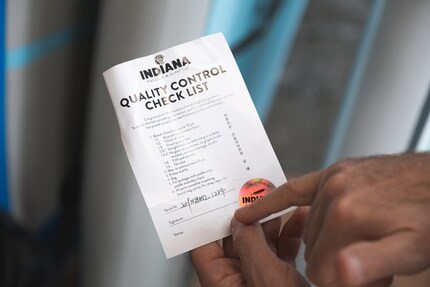
Whoever thinks that a board like this is spit off the assembly line more or less fully automatically is wrong. "There are many manual steps involved, the workers are extremely important," emphasises Strobel. "It only comes out well if someone works well." However, it is also true that inexpensive models have a right to exist. "If you only spend three weekends a year on the board with your family in Ticino, then that's enough. As soon as you paddle regularly, you'll have more fun with a quality product."
At Indiana Paddle & Surf, they feel the pressure of the market. "We had to provide arguments as to why we are better. It's not enough just to have Indiana on it and a Swiss brand behind it," says Strobel. Well-rehearsed processes, a team of experts and good quality are one thing - nothing works without innovation and appropriate marketing. "Stand Up Paddling 2.0" is the collective term for the updates that are set to impress in 2020.
Clever details such as the two-part fin box, which makes folding easier, or the wheelie bag, which turns the paddle into a drawbar, are based on feedback from customers. Indiana is always incorporating small optimisations that are very popular in the scene. It's all about the details. Unique selling points that make life on the water or on the way there more enjoyable.
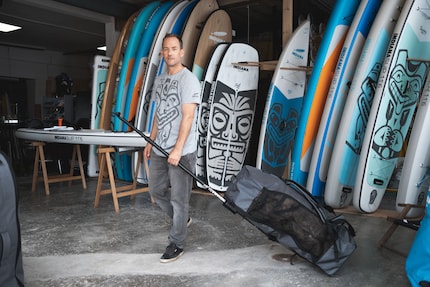
On the one hand, lightweight boards that are easy to carry to the most remote mountain lake are in demand. On the other hand, Maurus Strobel believes that SUP can still grow enormously as a competitive sport: "If racing becomes an Olympic sport at some point, then it will take off!" It would be a future in which high-quality hardboards are much more in demand again. There are many ideas, as well as the corresponding products, and the next trend wave is already rolling in with foiling.
Even the coronavirus crisis has largely spared the industry. People are being drawn to the water and the weeks-long shutdown in the Chinese factories could be bridged: "The second production unit arrived on the Trans-Siberian Railway," says Strobel. "It costs twice as much as by container ship, but it's faster and more environmentally friendly."
However, he cannot and will not gloss over the environmental aspect: "These products are clearly not compostable. It's PVC, glue, EVA - it all contains harmful substances. Our idea is to make the products so good that they last a long time." Making the old good and the new better, that's what it's all about. And about the fun and passion that a board awakens underfoot.
Of course, this also applies to Maurus Strobel, who is not only to be found on the water with his SUP. "I go wakefoiling, wakesurfing, windsurfing, kitesurfing and kitefoiling," says the board freak. "I also do windfoiling, just not as well," he adds and, while the layman is still sorting out the terms in his head, he adds apologetically: "I don't have time for that." The answer to the question of why this is the case is easy to guess: He just does everything with boards - even in the office.
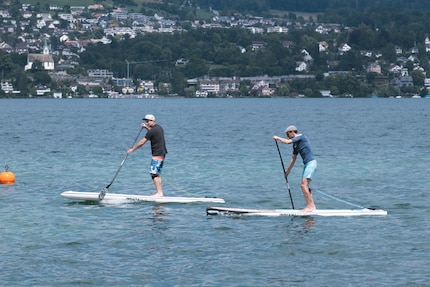
Simple writer and dad of two who likes to be on the move, wading through everyday family life. Juggling several balls, I'll occasionally drop one. It could be a ball, or a remark. Or both.
Interesting facts about products, behind-the-scenes looks at manufacturers and deep-dives on interesting people.
Show all